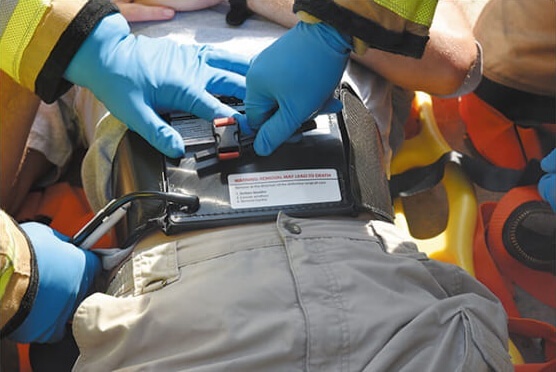The AAJT-S continues to be the only junctional and true truncal tourniquet to have saved life in upper and lower junctional hemorrhage.
 Birmingham, November 8, 2016 — In 2016, the number of Alabama Law Enforcement Agencies (LEAs) with access to the AAJT-S has more than doubled due to threats and officer assassination attempts around the country. In the event of life-threatening injury with massive, difficult to control bleeding, responding officers can render first aid in unsecured areas before paramedics arrive. Police, sheriff’s departments and SWAT units in from Mobile to Birmingham are now equipped to save lives in high risk operations or officer targeted shootings. “The AAJT-S has been used in overseas battlefields to save lives since 2012. Over a dozen militaries around the world have it as well as select EMS, trauma centers, federal, county and municipal law enforcement agencies,” said Chris Richards, U.S. civilian sector business developer for Compression Works. “We are proud to partner with our home-state LEAs as we deliver lessons learned on the battlefield to U.S. LE, hospitals and prehospital departments.” Co-inventor Dr. John Croushorn, Birmingham ER physician and former U.S. Army Task Force flight surgeon, began development of the AAJT-S after deployments in Iraq where extremity and junctional bleeding was once the leading cause of preventable death.
Birmingham, November 8, 2016 — In 2016, the number of Alabama Law Enforcement Agencies (LEAs) with access to the AAJT-S has more than doubled due to threats and officer assassination attempts around the country. In the event of life-threatening injury with massive, difficult to control bleeding, responding officers can render first aid in unsecured areas before paramedics arrive. Police, sheriff’s departments and SWAT units in from Mobile to Birmingham are now equipped to save lives in high risk operations or officer targeted shootings. “The AAJT-S has been used in overseas battlefields to save lives since 2012. Over a dozen militaries around the world have it as well as select EMS, trauma centers, federal, county and municipal law enforcement agencies,” said Chris Richards, U.S. civilian sector business developer for Compression Works. “We are proud to partner with our home-state LEAs as we deliver lessons learned on the battlefield to U.S. LE, hospitals and prehospital departments.” Co-inventor Dr. John Croushorn, Birmingham ER physician and former U.S. Army Task Force flight surgeon, began development of the AAJT-S after deployments in Iraq where extremity and junctional bleeding was once the leading cause of preventable death.
The device was first sent to Afghanistan in 2012 with U.S. Special Operations Forces. The first first military save was in April 2013. Later that year, Dr. Croushorn used it at Princeton Baptist Medical Center in Birmingham to save the first two civilian lives, which involved severe bleeding from gunshot wounds to the shoulder and legs. “I would have been the doctor to tell his mom, ‘I’m sorry, your son has passed away,” said Croushorn of one particular event. “That weekend, I went to check on the guy at the hospital, and I got to meet his mom and dad.
His mom just walked over and gave me a big hug and thanked me for saving her son’s life.” The AAJT-S is FDA indicated for difficult to control bleeding in the pelvis as well as upper and lower extremities. When placed in the abdomen, it compresses a major artery that supplies all blood flow to the pelvis, groin and legs. In essence, it “turns off the faucet” in cases of severe bleeding in the pelvis or both legs. When placed in the groin, it stops blood flow to a single leg. This type of injury was shown in a femoral artery wound scene in the popular 2001 movie, “Blackhawk Down.” The AAJT-S can also be placed in the shoulder to stop blood flow in penetrating wounds or amputations.
The AAJT-S continues to be the only junctional and true truncal tourniquet to have saved life in upper and lower junctional hemorrhage. It is the only device that is indicated to stop pelvic bleeding. It is the most studied device for junctional hemorrhage and it remains the only junctional device to have human studies demonstrating safety and effectiveness at each of its application sites. Homewood, AL police officer Greg Brundage commented, “Our team carries the AAJT-S on every op and it’s an essential part of our kit. It gives us extra confidence so we can perform better. If one of us is injured by gunfire, we know we have the best bleeding control equipment. That’s real peace of mind.” About Trauma Care in U.S. Law Enforcement “Line of Duty Deaths strike at the heart of us as peace officers and represents the ultimate sacrifice as public servants,” Texas Sheriff Ron Hickman told Breitbart Texas in an exclusive interview. Line of duty deaths are up by 5 percent in 2016 over the same time period in 2015 according to the ODMP. 2015’s total of 130 was down from 2014’s reported deaths of 146 officers. “Clearly the past couple of years have been traumatic ones for law enforcement,” Sheriff Hickman stated. “These two years represent a change in the historic trends in line of duty deaths. Direct and unprovoked shootings of officers are a divergence from deaths from confrontations. Fortunately, the improvements in tactical gear and ballistic vests coupled with improvements in trauma care have combined to help reduce the number of fatalities.” – Bob Price, Breitbart, http://www.breitbart.com/texas/2016/11/07/report-nearly-1800-cops-killed-past-10-years/. About The Abdominal Aortic and Juntional Tourniquet (AAJT-S) The AAJT-S is a circumferential device that utilizes a belt, windlass, and pneumatic pressure to compress the indicated regions of the body.
The belt and windlass together greatly increase the stability of the compression. The pneumatic wedge-shaped bladder provides focused pressure to squeeze the blood vessels passing through the region of application and preventing flow. In essence, the AAJT-S acts as a valve to figuratively “turn off the faucet” and prevent the further flow of blood out of wounds distal to its application site. About Compression Works Birmingham, Alabama-based Compression Works LLC specializes in the research, development of severe hemorrhage control devices. Compression Works’ novel AAJT-S device is used by militaries around the world, government agencies, select hospitals and law enforcement agencies. It is currently being launched to U.S. hospital and prehospital markets, such as trauma centers, rural hospitals, fire and rescue, EMS and various first responder units.

